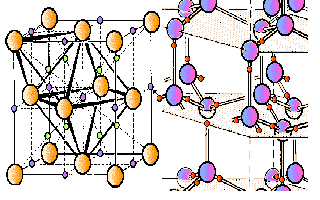JET Thermal Products
|
Home Page
JET Thermal Products
JET Thermal Products
JET Thermal Products
|
|
|
|
|
|
|
|
|
Heat Products to Serve You |
JET Thermal Products' Introduction to Cold Fusion
COLD FUSION
- Drs. Martin Fleischmann and Stanley Pons initially underemphasized the fact that the cold fusion reactions involve materials which are very difficult to prepare. This introduction is a scientific background which will discuss cold fusion, and some of the science involved. This information, like the reasons why the reactions are difficult to obtain, has become clearer only after understanding and control of the physics, material science and engineering was worked out. References are provided below.
- Since the announcement of the discovery of cold fusion in March 1989, laboratories in over 30 countries have investigated the cold fusion phenomena. Nonetheless, scientists and researchers in this field field, the science and engineering of loading isotopic fuels (such as hydrogen) into a material (such as palladium) have been facing a difficult struggle involving metallurgy, electrochemistry, and nuclear and solid-state physics.
- JET Thermal Products has significantly contributed to the development of the evolving landscape of cold fusion -- and its utilization, by developing a continuum electrophysics model which has led to codeposition, the optimal operating point, and Phusor technology, and by developing a series of devices which has led to the MIT ICCF-10 Cold Fusion Demonstration. We have sought not only the better performance, improved understanding and control of the physics, better and more diverse materials, and advanced engineering, but also quality assurance and quality control. By tackling this advancing science with these new ideas, we have moved closer to maximizing the rate of the desired safe heat producing reactions.
COLD FUSION BACKGROUND:
Cold fusion times, ISSN #1072-2874
Swartz. M., "Patterns of Success in Research Involving Low-Energy Nuclear Reactions", Infinite Energy, 31, 46-48, (2000).
MECHANISMS OF HEAT PRODUCTION
USING CONVENTIONAL PHYSICS and IMPROVED ENGINEERING
Cold fusion is the generation of, what was initially thought to be "anomalous", 'excess' heat at low temperatures. As Dr. Melvin Miles (China Lake, US Navy; COLD FUSION TIMES issue #V1-2) and others have demonstrated, helium, used to fill ordinary lighter-than-air balloons, is the product generated by the cold fusion reactions, if adequate loading and other engineering factors have been achieved (COLD FUSION TIMES issues #V2-1, 3-1, 4-1). The helium is generated by, and linked to, the production of excess heat. This helium is beyond the amount which can leak in from the ambient environment when metal flasks are used to isolate the reactions from the environment. This generation of energy -- with a safe product for a change -- is therefore quite important.
|
- Cold fusion technology has developed using several materials which now include palladium, titanium, nickel, and other metals in a variety of configurations. Early on, considerable focused upon the use of alloys, additives, and other techniques (e.g. COLD FUSION TIMES issues #V1-3, 3-2, 4-2, etc.). Preparation of the proper loaded, prepared, and poised materials has led to higher power levels and recognition of the product - helium.
MATERIAL DEVELOPMENTS
|
||
|
QUASI-ONE-DIMENSIONAL (Q1D) MODEL OF LOADING
This continuum electrophysics model has successfully led to understanding of loading, device failure, codeposition, the optimal operating point, and Phusor technology. The equations enabled production of a series of devices robust enough for the MIT ICCF-10 Cold Fusion Demonstration.
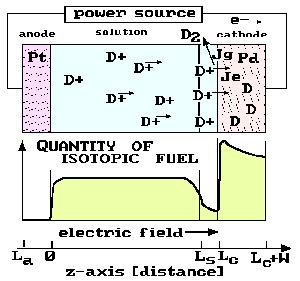 |
| The figure [after Swartz, Fusion Technology, 296-300 (1992)] qualitatively shows the loading of the material (palladium) with the inhomogeneous distribution of isotope (deuterium obtained from heavy water) . |
|
![]() QUASI-ONE-DIMENSIONAL
(Q1D) MODEL BACKGROUND
QUASI-ONE-DIMENSIONAL
(Q1D) MODEL BACKGROUND
Swartz, M, "Quasi-One-Dimensional Model of Electrochemical
Loading of Isotopic Fuel into a Metal", Fusion Technology, 22, 2, 296-300
(1992).
Swartz, M., "Isotopic Fuel Loading Coupled to Reactions
at an Electrode", Fusion Technology, 26, 4T, 74-77 (1994)
Swartz, M., "Isotopic Fuel Loading Coupled to Reactions
at an Electrode", 4, Proceedings: 'Fourth International Conference on Cold
Fusion", sponsored by EPRI and the Office of Naval Research, December
(1993).
Swartz, M., "Codeposition of Palladium and Deuterium",
Fusion Technology, 32, 126-130 (1997).
Swartz, M., "Generalized Isotopic fuel Loading Equations",
"Cold fusion Source book, International Symposium on Cold Fusion and Advanced
Energy systems", Ed. Hal Fox, Minsk, Belarus, May (1994).
NOISE MEASUREMENT, USE OF CONTROLS,
AND THERMAL SPECTROSCOPY
PERMIT IMPROVED SAMPLE INVESTIGATIONS
PALLADIUM SYSTEMS
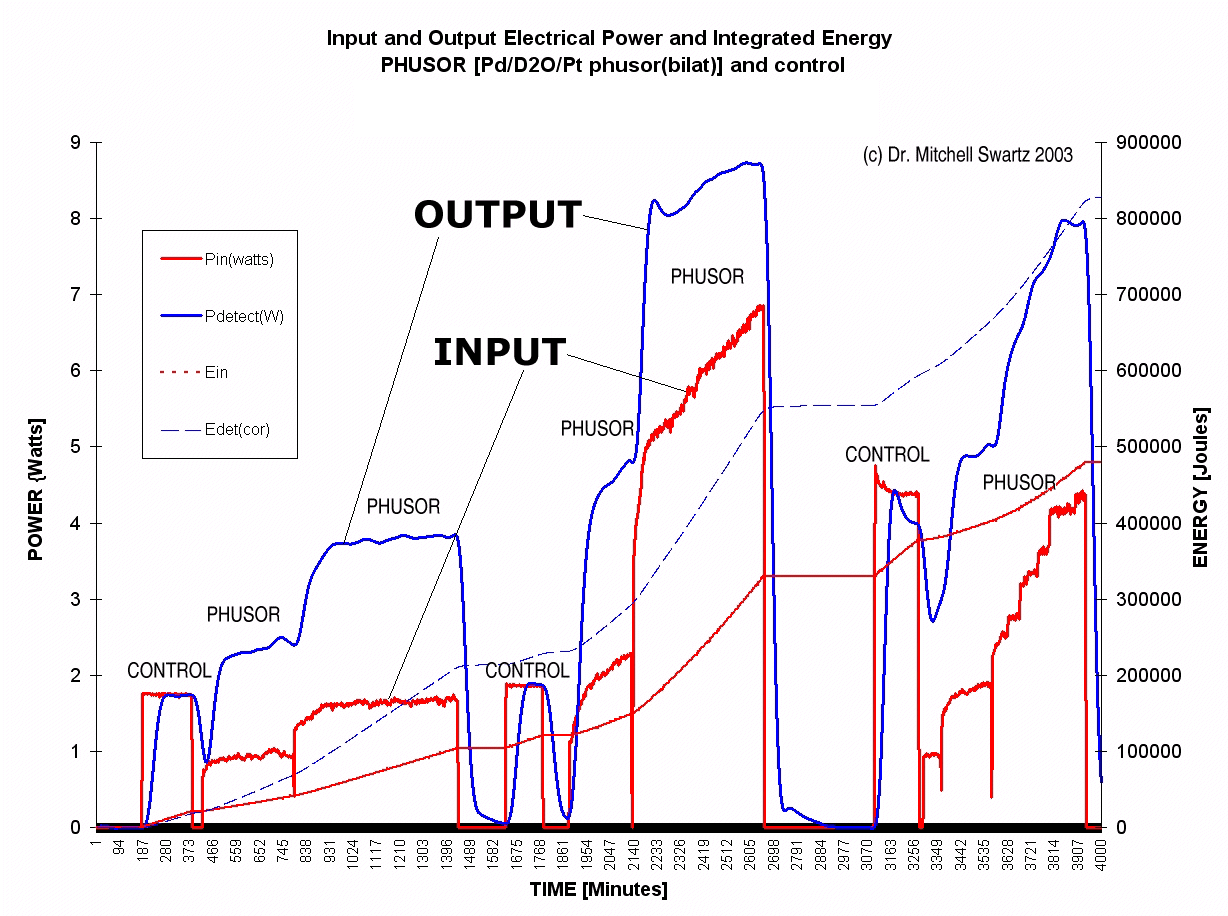
- It should be noted that the observed output power is much greater for the deuterium-loaded system as compared to the thermal (joule) controls. There are two additional energy curves in the figure that corroborate the excess heat of the deuterium-loaded palladium system compared to the control. The figure shows the integrated energy curves.
- The figure shows that in this run, there was an excess heat developed of more than 300,000 joules compared to the control.
(and energies) as a function of time
for the Phusor system and the electrical control
This figure shows the output of a moderate performance cold fusion system. The figure is a graph which has four curve.The graph shows the input electrical power and observed output heat power as a function of time over several days, both for the heavy water deuteron-loaded system and for the electrical control. Also shown, are the integrated input energy and integrated energy output of both the cold fusion device and the control, over several days.
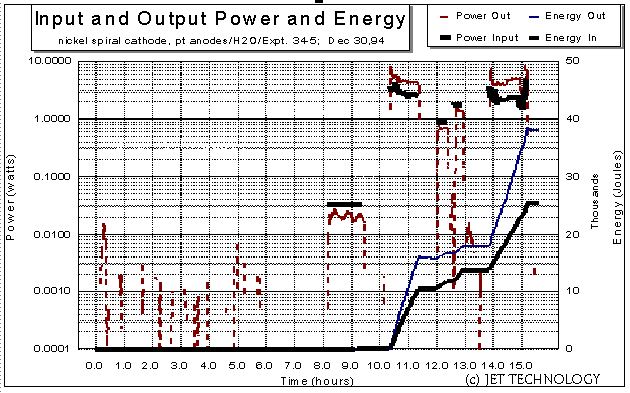
The figure above shows the input and output power (and energy) of a JET Thermal Products Nickel Phusor. This thermal spectrogram presents the input and output power along with energies of a platinum foil electrode (4 cm2 area) and a spiral nickel cathode (4.8 cm2 area, 0.059 cm3 volume) -- in ordinary light water. The graph results the power and energy of two JET Energy Technology generators, compared with three ohmic (Joule, or thermal) control pulses. The two solid lower lines are energy curves (input and output). They should be read off the right y-axis. The remainder of the curves are power curves and are read on the logarithmic left y-axis. The lower left shows the background noise and settling time of the experiment which characterizes the system.
Swartz. M., G. Verner, "Excess Heat from Low Electrical Conductivity Heavy Water Spiral-Wound Pd/D2O/Pt and Pd/D2O-PdCl2/Pt Devices", ICCF-10 (Camb. MA), Proceedings of ICCF-10, (2003).
Swartz, M, "Improved Electrolytic Reactor Performance Using p-Notch System Operation and Gold Anodes", Transactions of the American Nuclear Association, Nashville, Tenn 1998 Meeting, (ISSN:0003-018X publisher LaGrange, Ill) 78, 84-85, (1998).
Swartz, M., "Biphasic Behavior in Thermal Electrolytic Generators Using Nickel Cathodes", IECEC Proceedings, paper #97009 (1997).
OPTIMAL OPERATING POINTS
SOME EARLY PROBLEMS
WERE OPTIMAL OPERATING POINT RELATED
- In 1997, Dr. Mitchell Swartz reported that electrodes had to be driven at a precise in the input electrical power phase space for efficient operation, and that by considering such, different samples could be evaluated with respect to each other. This is optimal operating point of each system. Comprehending the "Optimal Operating Point"--the site at which the reaction is best operated--around which each device is designed and carefully constructed has been one major key to understanding and developing cold fusion. We have learned that the reactions occur only after successful loading of an active metal by an isotope of hydrogen (reactions to the left of the peak), and that excessive input of electrical power is wasteful (reactions to the right of the peak).
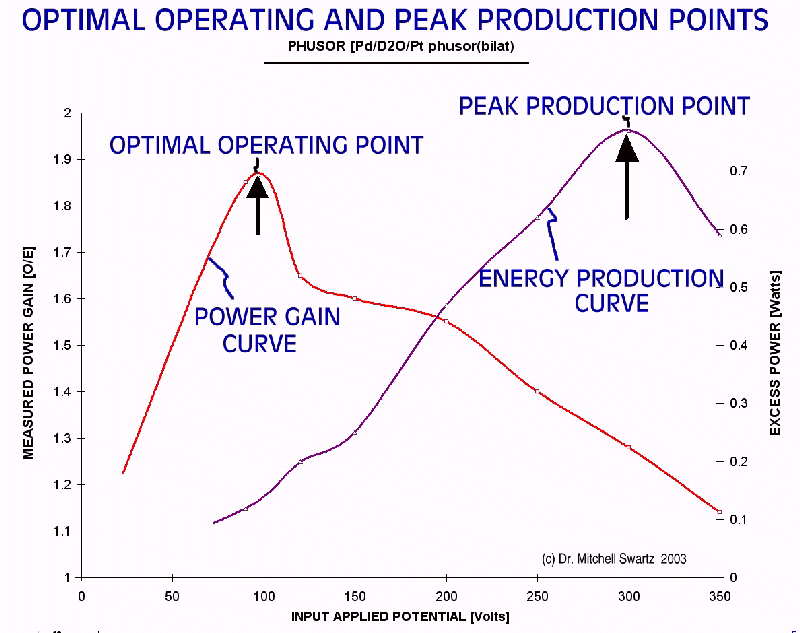
Optimal Operating Point and Peak Production Point
In a Pd/D2O/Pt Phusor System
The figure above shows power gain and the energy production curves for a JET Palladium Phusor as a function of applied voltage across the device. As Dr. Swartz has demonstrated in several cold fusion systems, an optimal operating point can be seen. This narrow peak (maximum) of the power gain and production curve for the products is observed for the desired reactions (heat and trace amounts of helium-4) as a function of input electrical power. Driving with electrical input power beyond the optimal operating point does not improve the production of the desired product or power gain, but instead yields a less than desirable falloff of the production rate and power gain with increasing input power.
Swartz. M., "Control of Low Energy Nuclear Systems through Loading and Optimal Operating Points", ANS/ 2000 International Winter Meeting, Nov. 12-17, 2000, Washington, D.C. (2000)OPTIMAL OPERATING POINT BACKGROUND
Swartz. M., G. Verner, A. Frank, H. Fox "Importance of Non-dimensional Numbers and Optimal Operating Points in Cold Fusion", Journal of New Energy, 4, 2, 215-217 (1999)
Swartz, M., "Generality of Optimal Operating Point Behavior in Low Energy Nuclear Systems", Journal of New Energy, 4, 2, 218-228 (1999)
Swartz, M, "Optimal Operating Point Characteristics of Nickel Light Water Experiments", Proceedings of ICCF-7, (1998).
Swartz, M, "Comparative p-notch [Optimal Operating Point] Characteristics of Solid State Nuclear Systems, Infinite Energy, 20, 69, (1998)
--- END of Part I ---
|
Energy Prdxn |
ICCF10 Demo |
10K Driver |
Phusor |
Adv. Systems |
|
Products |
Analysis |
Testing |
Refs |
|
|
TIMES |
Index |
Timeline |
Refs |
Skeptics |
|
Current Iss. |
Books |
|
|
Science |
 JET Thermal Products
JET Thermal Products
P.O. Box 81135
Wellesley Hills, MA USA 02481-0001
Home Page| Background| Publications |
| Add'l Refs | Contact |
JET Thermal Products

